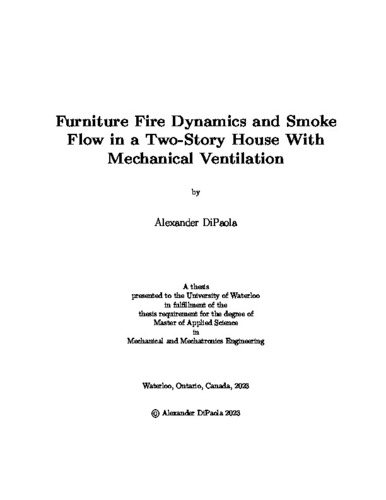UWSpace will be migrating to a new version of its software from July 29th to August 1st. UWSpace will be offline for all UW community members during this time.
Furniture Fire Dynamics and Smoke Flow in a Two-Story House With Mechanical Ventilation
| dc.contributor.author | DiPaola, Alexander | |
| dc.date.accessioned | 2023-12-11 20:36:02 (GMT) | |
| dc.date.available | 2023-12-11 20:36:02 (GMT) | |
| dc.date.issued | 2023-12-11 | |
| dc.date.submitted | 2023-12-04 | |
| dc.identifier.uri | http://hdl.handle.net/10012/20150 | |
| dc.description.abstract | Synthetic materials in modern furniture, combined with airtight construction practices developed as a response to the call for energy efficient homes, have increased the likelihood of a residential fire becoming ventilation (oxygen) limited. This poses unique risks for occupants and firefighters. There is a fundamental lack of knowledge of the development of modern fire scenarios and how factors such as decreasing compartment oxygen levels or operational mechanical ventilation systems may affect the fire behaviour. In the past, most studies have focused on investigation of ventilation-limited fires at reduced scales or well-ventilated fires at large scale, leaving gaps in both data and understanding when it comes to full-scale, ventilation-limited fires. As part of a larger project, a series of four furniture fire experiments are conducted in a two-storey, multi-compartment burn house, using identical fuel loads under different mechanical ventilation configurations. The burn house is configured with a typical home layout and has been sealed to mimic an energy efficient home. For the experiments, it is equipped with a mechanical ventilation system set to provide typical residential flow rates that might occur during a fire: (1) no ventilation, (2) baseline ventilation, (3) 2x baseline ventilation, and (4) recirculation. Instrumentation is included in all compartments to chart fire growth, smoke flow, and fire induced environment factors such as temperature and gaseous species concentrations. Data from these four experiments is presented to characterize the effects of mechanical ventilation on fire development, smoke flow, and gaseous species distribution throughout the structure and the resulting fire induced room environments. In addition, the data is used to evaluate the effectiveness of existing engineering correlations at predicting certain key parameters that describe development of the fire induced environment. The results discussed throughout this thesis provide spatially and temporally resolved novel data to enhance the current limited understanding of modern furniture fires in multi-storey, multi-compartment structures when a mechanical ventilation system is operational. Specific results allow improved characterization of how modern furniture burns in full-scale ventilation-limited compartments and the impact of mechanical ventilation on these scenarios. The data is critical for improvement of engineering correlations and design guidelines for this category of fires, and over the longer term may be used for validation of more detailed fire models and a foundation for future research. | en |
| dc.language.iso | en | en |
| dc.publisher | University of Waterloo | en |
| dc.subject | furniture fire | en |
| dc.subject | ventilation-limited fire | en |
| dc.subject | mechanical ventilation | en |
| dc.subject | fire dynamics | en |
| dc.subject | smoke flow | en |
| dc.subject | fire induced enviornment | en |
| dc.subject | fire engineering correlations | en |
| dc.title | Furniture Fire Dynamics and Smoke Flow in a Two-Story House With Mechanical Ventilation | en |
| dc.type | Master Thesis | en |
| dc.pending | false | |
| uws-etd.degree.department | Mechanical and Mechatronics Engineering | en |
| uws-etd.degree.discipline | Mechanical Engineering | en |
| uws-etd.degree.grantor | University of Waterloo | en |
| uws-etd.degree | Master of Applied Science | en |
| uws-etd.embargo.terms | 0 | en |
| uws.contributor.advisor | Weckman, Elizabeth | |
| uws.contributor.affiliation1 | Faculty of Engineering | en |
| uws.published.city | Waterloo | en |
| uws.published.country | Canada | en |
| uws.published.province | Ontario | en |
| uws.typeOfResource | Text | en |
| uws.peerReviewStatus | Unreviewed | en |
| uws.scholarLevel | Graduate | en |

